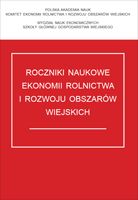Main Article Content
Article Details
Czyżewski A. 1995: Makroekonomiczne uwarunkowania przedsiębiorczości w agrobiznesie, [w] Rozwój rolnictwa i agrobiznesu w skali lokalnej, A. Czyżewski (red.), Wyd. ODR w Sielinku, Poznań.
Czyżewski A. 2007: Makroekonomiczne uwarunkowania rozwoju sektora rolnego, [w] Uniwersalia polityki rolnej w gospodarce rynkowej, A. Czyżewski (red.), Wyd. AE w Poznaniu, Poznań. (Crossref)
Gorzelak E., Zimny Z. 2010: Koniunktura w rolnictwie, Instytut Rozwoju Gospodarczego, SGH, Warszawa.
Hodges J. 1934: Size of the farms and the Business Cycle, "Journal of Farms Economics", vol. 14, no 1.
http://stats.oecd.org, dostęp luty 2013.
Jankowski S. 2001: Cykliczność rozwoju gospodarczego, [w] Makro i mikroekonomia - podstawowe problemy, S. Marciniak (red.), PWN, Warszawa.
Kavallari A., Fellman T., Gay S. 2011: Shocks in economic growth - shocking effects on agricultural markets? Paper prepared for the EAAE Congres in Zurich.
Klimkowska J., Stolorz S. 2008: Własności prognostyczne Barometru Koniunktury SGH i jego składowych w oparciu o wskaźnik referencyjny wahań cyklicznych dla gospodarki polskiej, "Prace i materiały Instytutu Rozwoju Gospodarczego SGH", nr 80.
Kufel J. 2012: Koniunktura a procesy rynkowe w sektorze rolno-żywnościowym, IERiGŻ-PIB, Warszawa.
Mrówczyńska-Kamińska A., Czyżewski B. 2011: Przepływy międzygałęziowe i podział rent w sektorze rolno-żywnościowym w Polsce w latach 1995-2005, "Ekonomista", nr 2.
Rembeza J, Seremak-Bulge J. 2009: Ewolucja podstawowych rynków rolnych i jej wpływ na transmisję cen w latach 1990-2008, IERiGŻ-PIB, Warszawa.
Sobiecki R. 2010: Kryzysy rolne a bezpieczeństwo żywnościowe, [w] Przedsiębiorstwo, a kryzys globalny, R. Sobiecki, J. Pietrewicz (red.). Wyd. SGH, Warszawa.
Stępień S. 2011: Związki wahań cyklicznych w rolnictwie z koniunkturą gospodarczą, Roczniki Nauk Rolniczych. Seria G, Ekonomika rolnictwa 98(3). (Crossref)
Wyniki standardowe uzyskane przez gospodarstwa rolne uczestniczące w polskim FADN. 2011, 2012: IERiGŻ, Warszawa.lw
Downloads
- Marek Gałązka, SOCIO-DEMOGRAPHIC DETERMINANTS OF HOUSEHOLDS FOOD EXPENDITURES IN POLAND , Annals of Agricultural Economics and Rural Development: Vol. 100 No. 1 (2013)
You may also start an advanced similarity search for this article.
- Aleksander Grzelak, Andrzej Czyżewski, Threats Agriculture In Poland In Light Of The General Economic Situation In Period Of Crisis 2007-2009 , Annals of Agricultural Economics and Rural Development: Vol. 98 No. 3 (2011)




